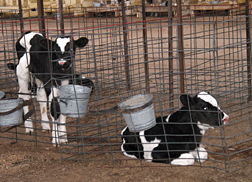|
|
||
| News Center |

|
|
|
|
||
|
|
||
| News Releases | Publications | Resources | Multimedia Gallery | Security Alert Information | ||
News Release Archive | Awards | ||
FOR IMMEDIATE RELEASE | ||
| BRAT may assess risks of terrorism, natural disasters to dairies, feedlots, ranches, food packaging | ||
| New tool is based on Sandia-developed RAMPART™ technology | ||
ALBUQUERQUE, N.M. — BRAT, a new tool based on the Sandia National Laboratories-developed software RAMPART™-GSA, may soon be applied to dairies, feedlots, ranches and food packaging. RAMPART™-GSA assesses the risks of terrorism, natural disasters and crime to government buildings managed by the US General Services Administration. “We are using the RAMPART™ [for Risk Assessment Method] technology to work on food production and processing entities, starting with dairies,” says Sandia researcher Regina Hunter, project lead. “At this point BRAT [for Biosecurity Risk Assessment Tool] is a collection of screens that ask questions about dairy location, numbers of buildings, how many cows there are, types of shelters for cows — things that could affect dairy farms.” The goal is to turn BRAT into something like RAMPART™-GSA. After filling out the screens, a set of equations run on a computer would determine the risk for an event at a particular dairy. It will ultimately include information about animal diseases, provide names of state veterinarians, and contain information such as regulations for shipping cattle between states. BRAT is one activity of Sandia’s Agriculture Security and Food Safety Pre-Initiative. Abram Van Der Geest, a student intern who developed BRAT under Hunter’s supervision, says BRAT is designed for use by farmers, who could, for example, download the software from an agricultural extension agency office and run it either at the agency or at the farm. BRAT would provide the farmers the information they need to determine risks to their facilities, giving them a starting point about what changes they needed to make in order to reduce risk factors. Over the summer Van Der Geest, Hunter and another intern, Brent Melville, spent some time with Joe Gonzalez, owner of the Gonzalez Dairy in Mesquite, N.M., to obtain information about how dairies operate and potential threats to dairy farms. The project was done under the auspices of Sandia’s Small Business Assistance Program. Dairy farming is a major industry in New Mexico — in 1999 cash receipts reached more than $687 million. Milk and other dairy products are the second largest income generator for New Mexico farmers and ranchers. Dairy cattle numbers exceeded 236,000 at the beginning of 2000, up from 218,000 in 1999. As a state, New Mexico ranks 10th in the US in overall milk production. “Obviously with dairy farming such a major industry in New Mexico, keeping dairies safe is a top priority, and BRAT could play a major role in that,” Abram says. Ultimately BRAT would be applied to other areas of the food industry, including feedlots, ranches, and food packaging. Hunter says that once BRAT is operational, it will have a direct impact on RAMPART™ technology. For example, BRAT should be able to do real-time updating, like gaining information on diseases that are moving through the country. RAMPART can’t do this now. “Having that real-time updating would be a real boon to RAMPART™-based tools,” Hunter says. BRAT could be fully operational in about two years — if funding becomes available, Hunter says. Sandia media contact: Chris Burroughs, coburro@sandia.gov, (505) 844-0948 Sandia technical contact: Regina Hunter, rlhunte@sandia.gov, (505) 844-5837
| ||
|
Back to top of page News Releases | Publications | Resources | Multimedia Gallery | Security Alert Information |
||
|
|
||
|
|
||
